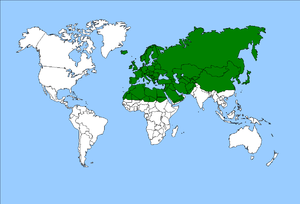A região paleoártica ou paleártico é a região zoogeográfica que inclui a Europa, Norte de África, grande parte da Arábia e a Ásia a norte do Himalaia. A palavra é composta do antepositivo paleo (grego: velho), em referência ao Velho Mundo, com ártico, com o significado de Norte.[1][2]
Estas designações seguem a antiga denominação de "Velho Mundo" para a Eurásia e a África, com o prefixo de "velho" (paleo em grego) - região paleártica ou paleoártica e região paleotropical e de "Novo Mundo" para as Américas, com o prefixo de "novo" (neo em grego) - região neoártica, sendo estes nomes aplicados às regiões biogeográficas.[1][2]
Esta região é parte de uma região ainda maior, a do complexo Holoártico, cuja maior parte dos animais mamíferos, pertencentes à superordem Laurasiatheria, são descendentes dos da Laurásia, um antigo continente do norte do Planeta Terra que se formou após a divisão do supercontinente Pangeia entre uma metade norte (a mencionada Laurásia) e uma metade sul, a Gondwana.[3][4][5][6] O mesmo se parece verificar em relação a muitas espécies de plantas.[1]
Regiões ecológicas
O Reino Paleoártico ou grande região Paleoártica divide-se em outras regiões biogeográficas mais pequenas:[1][2][7]
- Euro-Siberiana (Europa e Sibéria) (a maior da Paleoártica);
- Bacia do Mediterrâneo;
- Macaronésica (ou Macaronésia) (tem diversos arcaísmos biológicos, sobretudo nas plantas, pertencentes ao Reino florístico Holoártico);
- Irano-Turaniana ou Asiática Ocidental e Asiática Central;
- Sino-Japonesa ou Asiática Oriental (Setentrional);
- Saaro-Arábica (ou Saaro-Árabe) (faz a transição com a Afro-tropical ou Etíope ou Etiópica mas tem maior afinidade com a Paleoártica).
Ver também
Referências
- ↑ 1,0 1,1 1,2 1,3 Schultz, J. 2007. The Ecozones of the World. Traducido al inglés por B. Ahnert. Segunda Edición. Springer, Verlag, Netherlands.
- ↑ 2,0 2,1 2,2 Udvardy, M. D. F. (1975). A classification of the biogeographical provinces of the world. IUCN Occasional Paper no. 18. Morges, Switzerland: IUCN.
- ↑ Waddell PJ, Kishino H, Ota R (2001) A phylogenetic foundation for comparative mammalian genomics. Genome Inform Ser Workshop Genome Inform 12: 141–154.
- ↑ Kriegs, Jan Ole, Gennady Churakov, Martin Kiefmann, Ursula Jordan, Juergen Brosius, Juergen Schmitz. (2006) Retroposed Elements as Archives for the Evolutionary History of Placental Mammals. PLoS Biol 4(4): e91.[1] (pdf version)
- ↑ Waddell, P.J., Okada, N., & Hasegawa, M. (1999) Towards resolving the interordinal relationships of placental mammals. Systematic Biology 48(1):1-5 [M. Uhen/M. Uhen]
- ↑ William J. Murphy, Eduardo Eizirik, Mark S. Springer et al., Resolution of the Early Placental Mammal Radiation Using Bayesian Phylogenetics,Science, Vol 294, Issue 5550, 2348-2351 , 14 December 2001.
- ↑ Takhtajan, Armen, 1986. Floristic Regions of the World. (traduzido por T.J. Crovello & A. Cronquist). University of California Press, Berkeley.
Fontes
- Bennet, K. D.; J. H. Lawton; A. Gibbs; M. H. Williamson; M. W. Holdgate; W. D. Hamilton; G. R. Conway. 1986. The Rate of Spread and Population in Increase of Forest Trees During the Postglacial [and Discussion]. Philosophical Transactions of the Royal Society of London. Series B, Biological Sciences 314:1167:523-531.
- Blanchette M, Green ED, Miller W, Haussler D. (2004) Reconstructing large regions of an ancestral mammalian genome in silico. Genome Res. 2004 Dec;14(12):2412-23. ([2])
- Good, Ronald, 1947. The Geography of Flowering Plants. Longmans, Green and Co, Nova Iorque
- Kriegs, Jan Ole, Gennady Churakov, Martin Kiefmann, Ursula Jordan, Juergen Brosius, Juergen Schmitz. (2006) Retroposed Elements as Archives for the Evolutionary History of Placental Mammals. PLoS Biol 4(4): e91.[3] (pdf version)
- Ma J, Zhang L, Suh BB, Raney BJ, Burhans RC, Kent WJ, Blanchette M, Haussler D, Miller W. (2006) Reconstructing contiguous regions of an ancestral genome. Genome Res. 2006 Dec;16(12):1557-65. Epub 2006 Sep 18.([4])
- Morrone, J.J. 2002. Biogeographic regions under track and cladistic scrutiny. J. Biogeogr. 29: 149-152.
- Rodriguez, J;J. Hortal.;M. Nieto. 2006. An evaluation of the influence of environment and biogeography on community structure: the case of Holarctic mammals. Journal of Biogeography Vol. 33:2:291-303.
- Schultz, J. 2007. The Ecozones of the World. Traducido al inglés por B. Ahnert. Segunda Edición. Springer, Verlag, Netherlands.
- Taberlet, P.; R. Cheddadi 2002. Quaternary Refugia and Persistence of Biodiversity (in Science's Compass; Perspectives). Science, New Series 297:5589:2009-2010.
- Takhtajan, Armen, 1986. Floristic Regions of the World. (traduzido por T.J. Crovello & A. Cronquist). University of California Press, Berkeley.
- Udvardy, M. D. F. (1975). A classification of the biogeographical provinces of the world. IUCN Occasional Paper no. 18. Morges, Switzerland: IUCN.
- Waddell PJ, Kishino H, Ota R (2001) A phylogenetic foundation for comparative mammalian genomics. Genome Inform Ser Workshop Genome Inform 12: 141–154.
- Waddell, P.J., Okada, N., & Hasegawa, M. (1999) Towards resolving the interordinal relationships of placental mammals. Systematic Biology 48(1):1-5 [M. Uhen/M. Uhen]
- William J. Murphy, Eduardo Eizirik, Mark S. Springer et al., Resolution of the Early Placental Mammal Radiation Using Bayesian Phylogenetics,Science, Vol 294, Issue 5550, 2348-2351 , 14 December 2001.






 " class="attachment-atbs-s-4_3 size-atbs-s-4_3 wp-post-image" alt="O que estudar para o enem 2023">
" class="attachment-atbs-s-4_3 size-atbs-s-4_3 wp-post-image" alt="O que estudar para o enem 2023"> " class="attachment-atbs-s-4_3 size-atbs-s-4_3 wp-post-image" alt="Qual melhor curso para fazer em 2023">
" class="attachment-atbs-s-4_3 size-atbs-s-4_3 wp-post-image" alt="Qual melhor curso para fazer em 2023"> " class="attachment-atbs-s-4_3 size-atbs-s-4_3 wp-post-image" alt="Enem: Conteúdos E Aulas On-Line São Opção Para Os Estudantes">
" class="attachment-atbs-s-4_3 size-atbs-s-4_3 wp-post-image" alt="Enem: Conteúdos E Aulas On-Line São Opção Para Os Estudantes"> " class="attachment-atbs-s-4_3 size-atbs-s-4_3 wp-post-image" alt="Como Fazer Uma Carta De Apresentação">
" class="attachment-atbs-s-4_3 size-atbs-s-4_3 wp-post-image" alt="Como Fazer Uma Carta De Apresentação"> " class="attachment-atbs-s-4_3 size-atbs-s-4_3 wp-post-image" alt="Como Escrever Uma Boa Redação">
" class="attachment-atbs-s-4_3 size-atbs-s-4_3 wp-post-image" alt="Como Escrever Uma Boa Redação"> " class="attachment-atbs-s-4_3 size-atbs-s-4_3 wp-post-image" alt="Concurso INSS edital 2022 publicado">
" class="attachment-atbs-s-4_3 size-atbs-s-4_3 wp-post-image" alt="Concurso INSS edital 2022 publicado">


